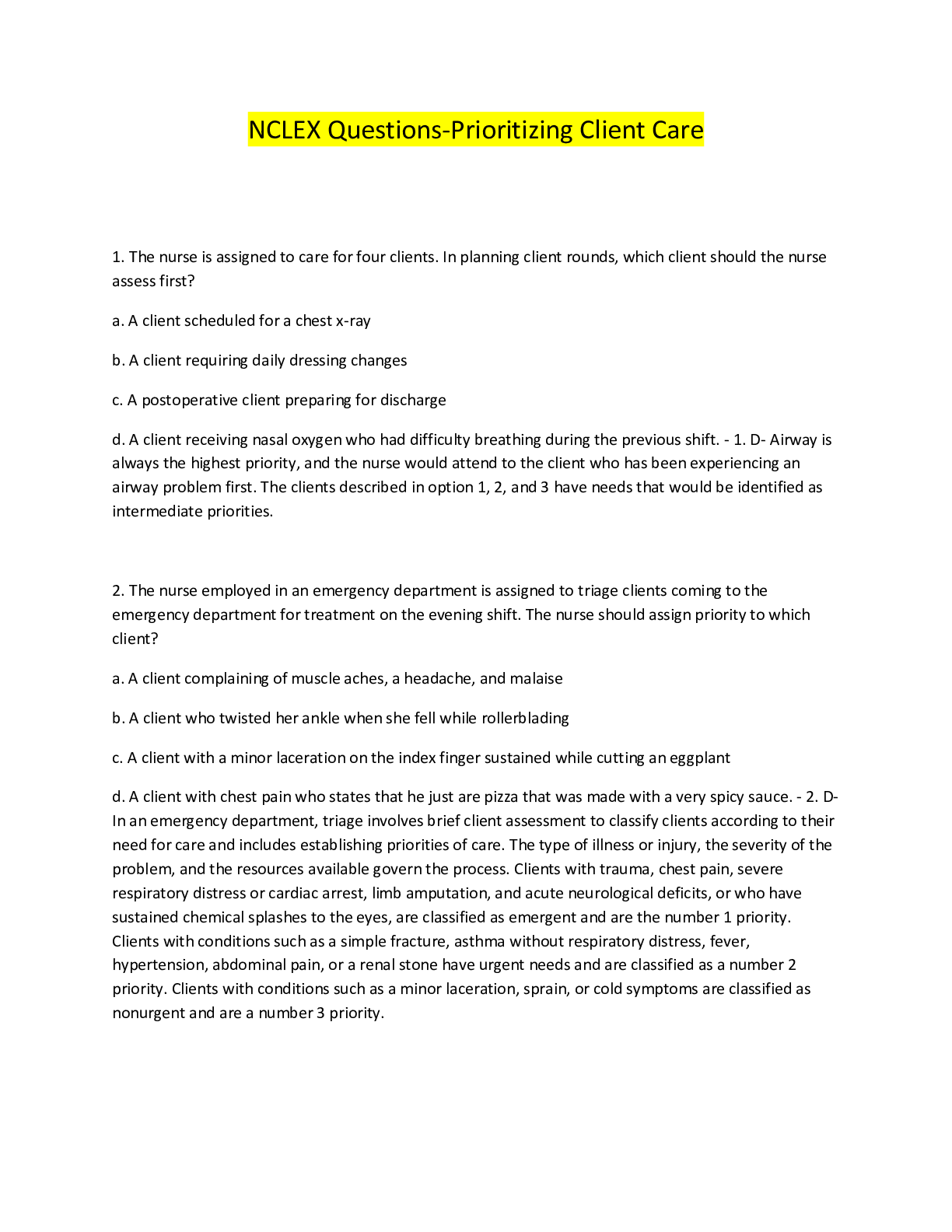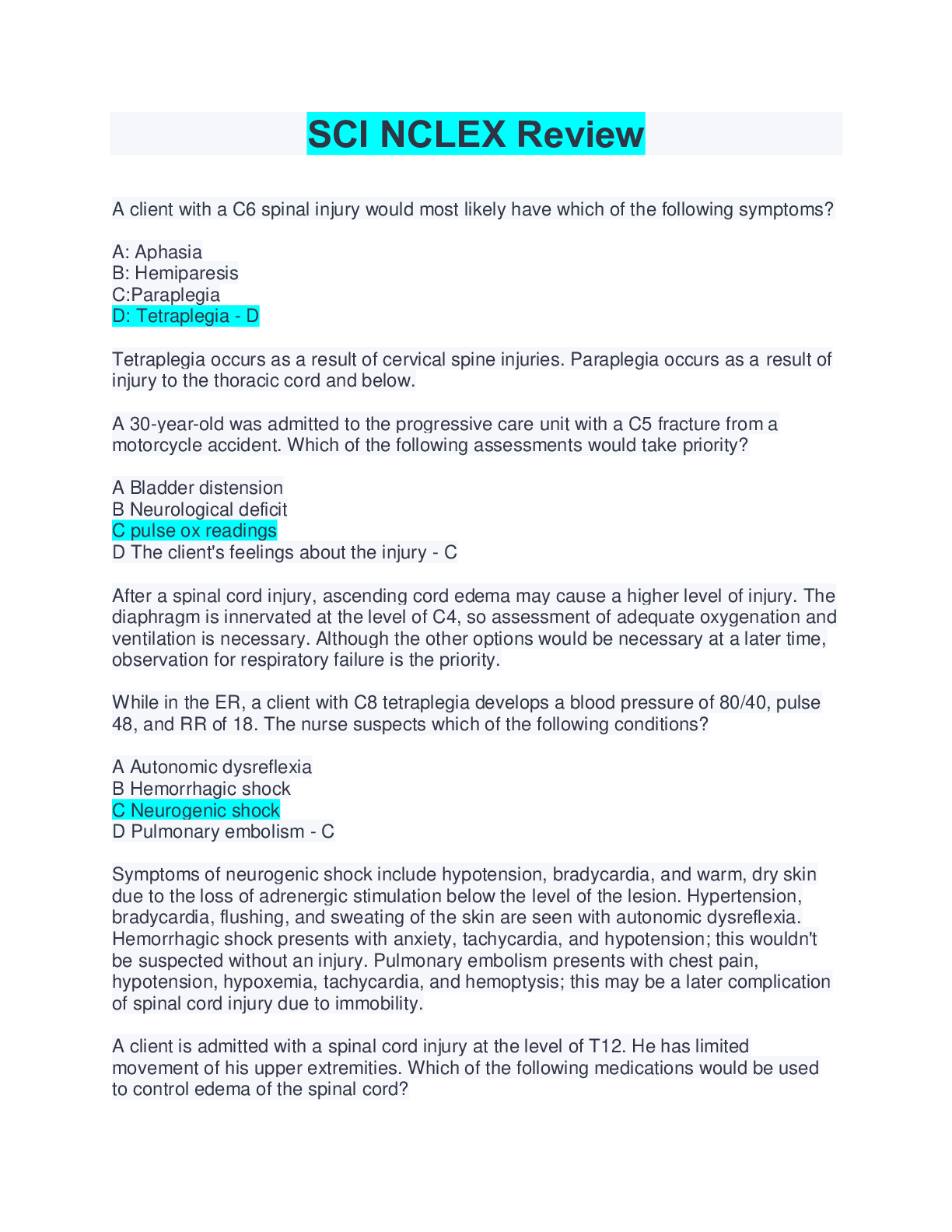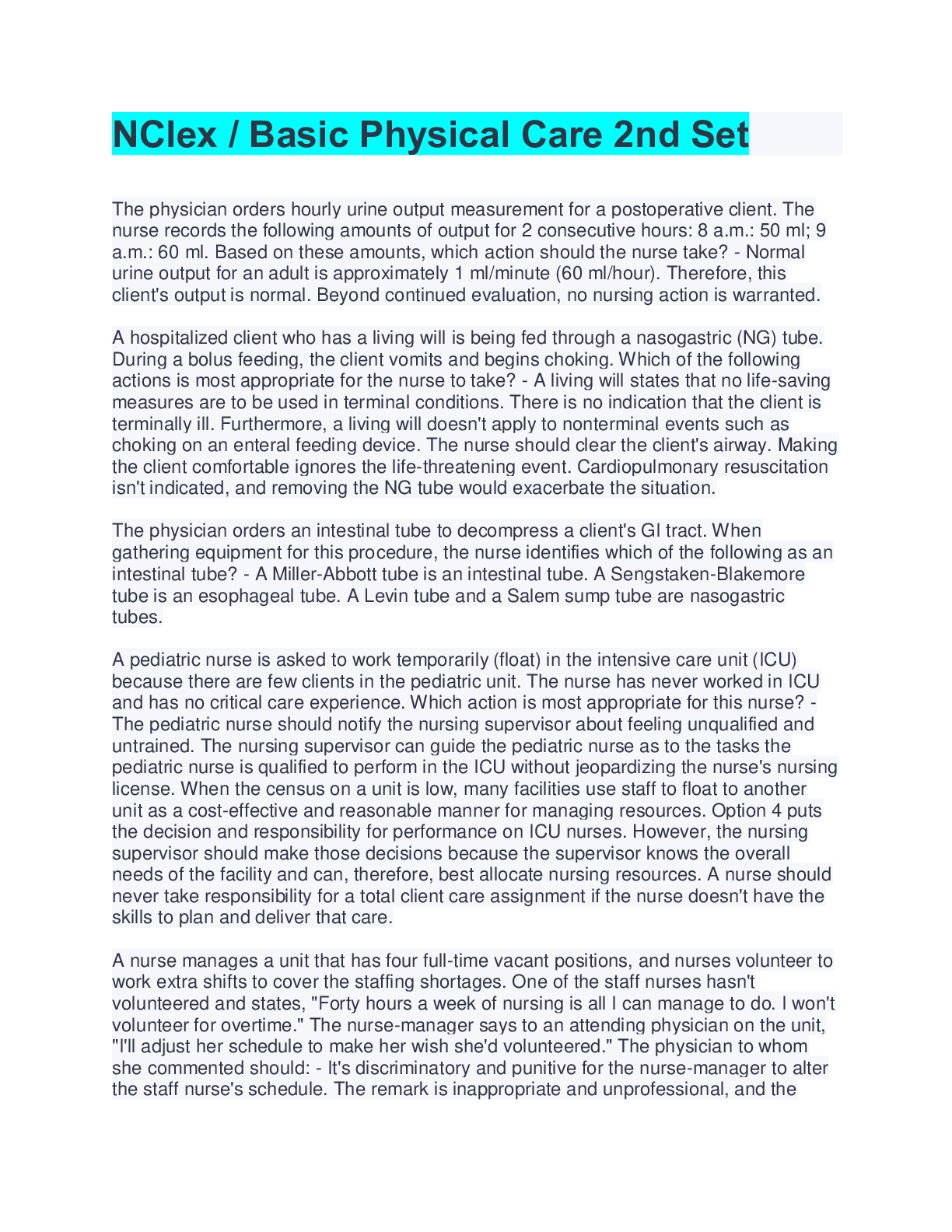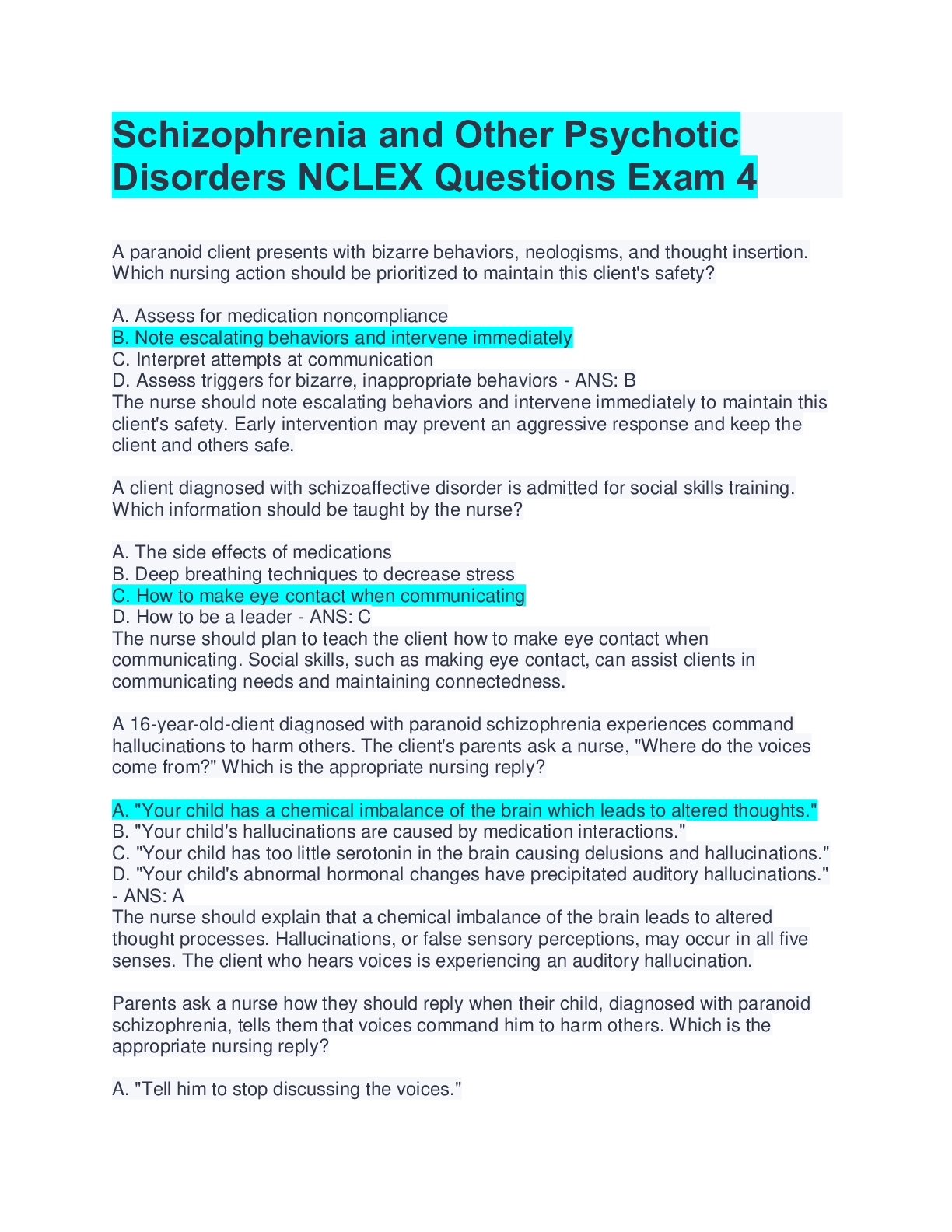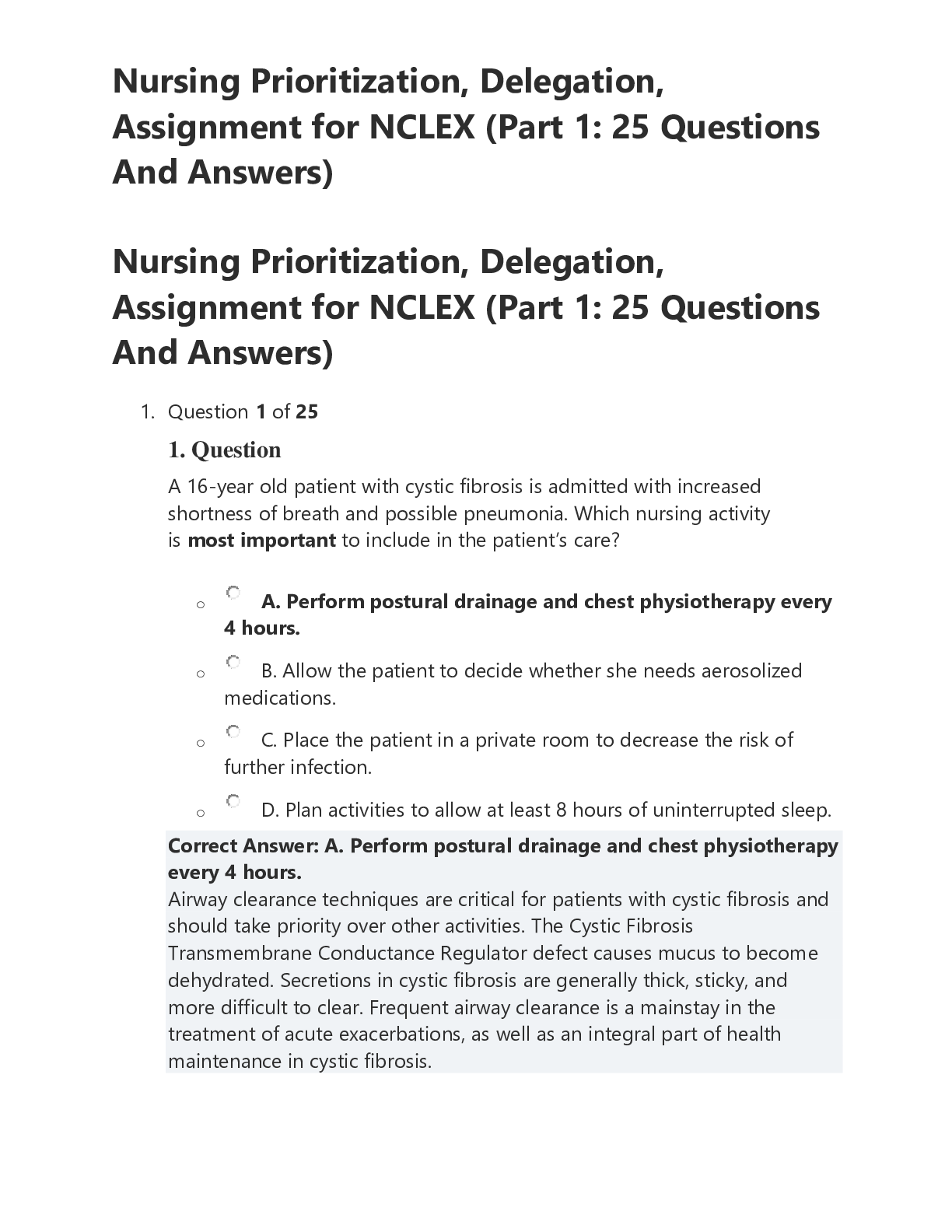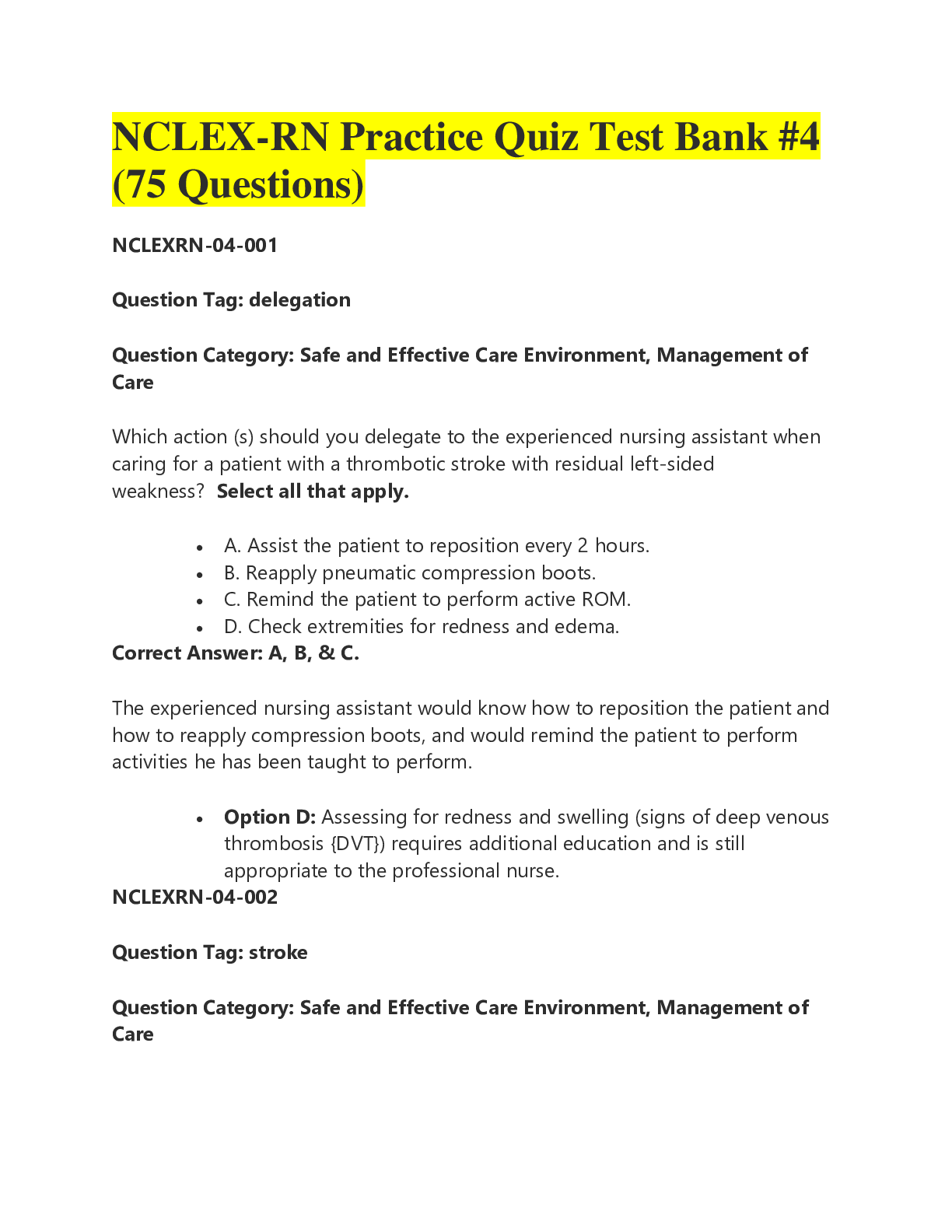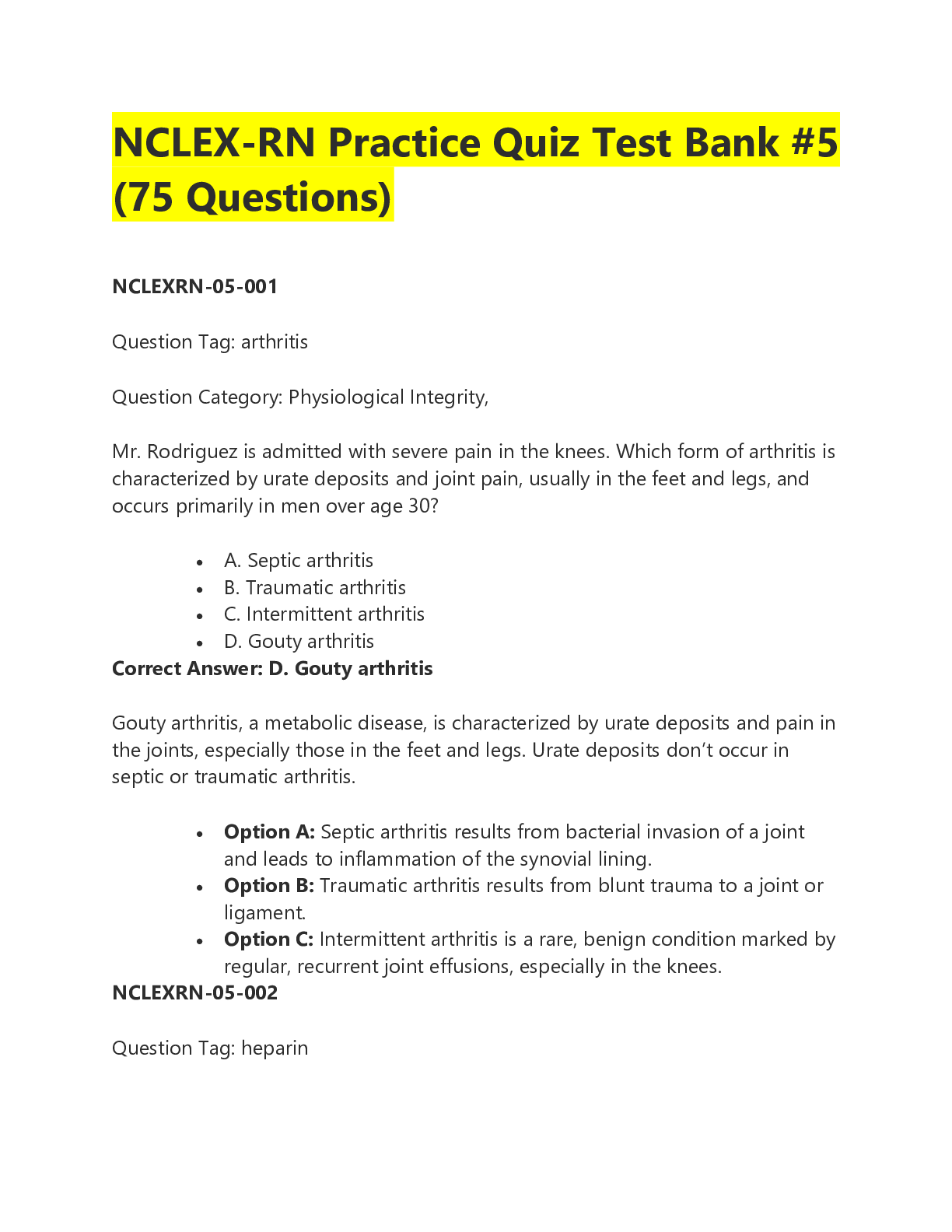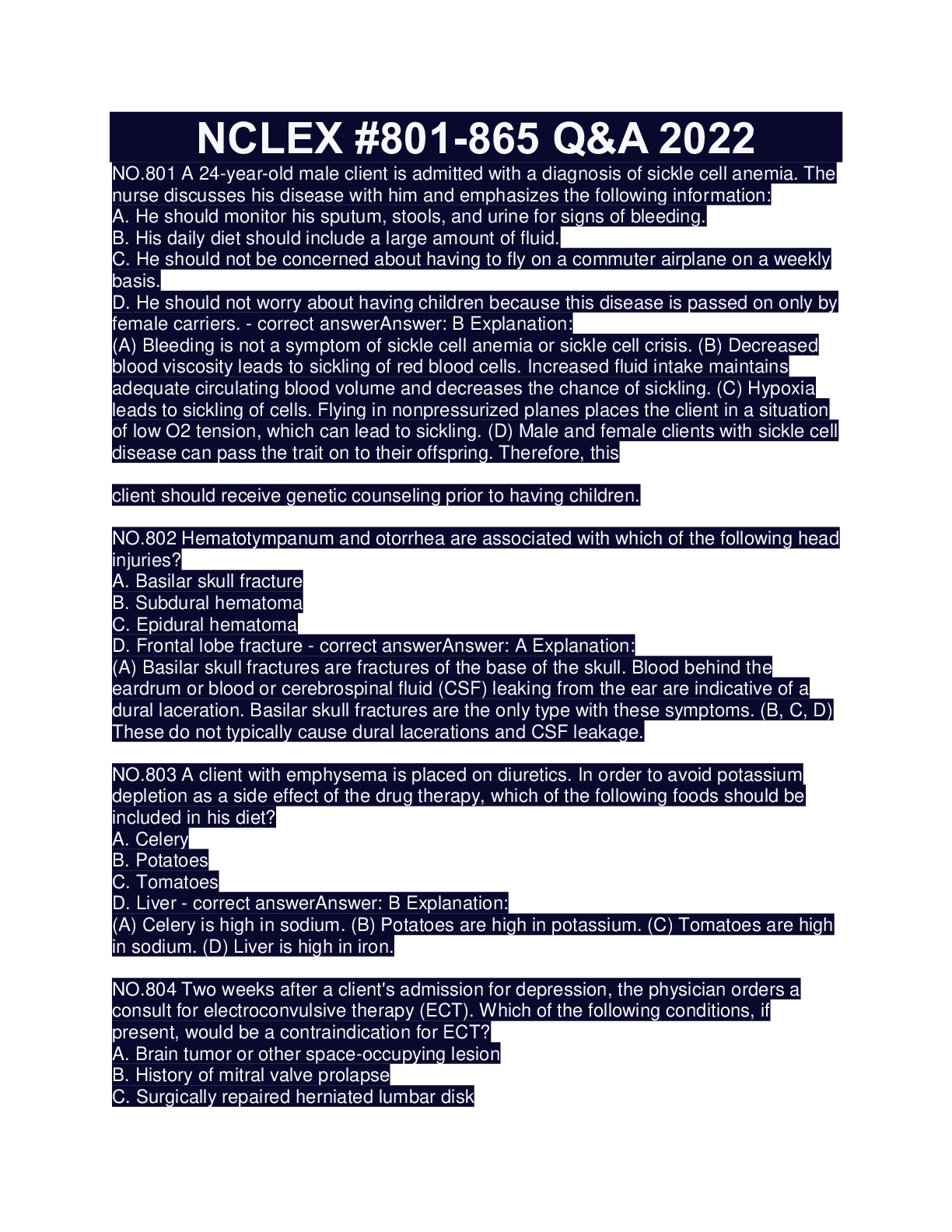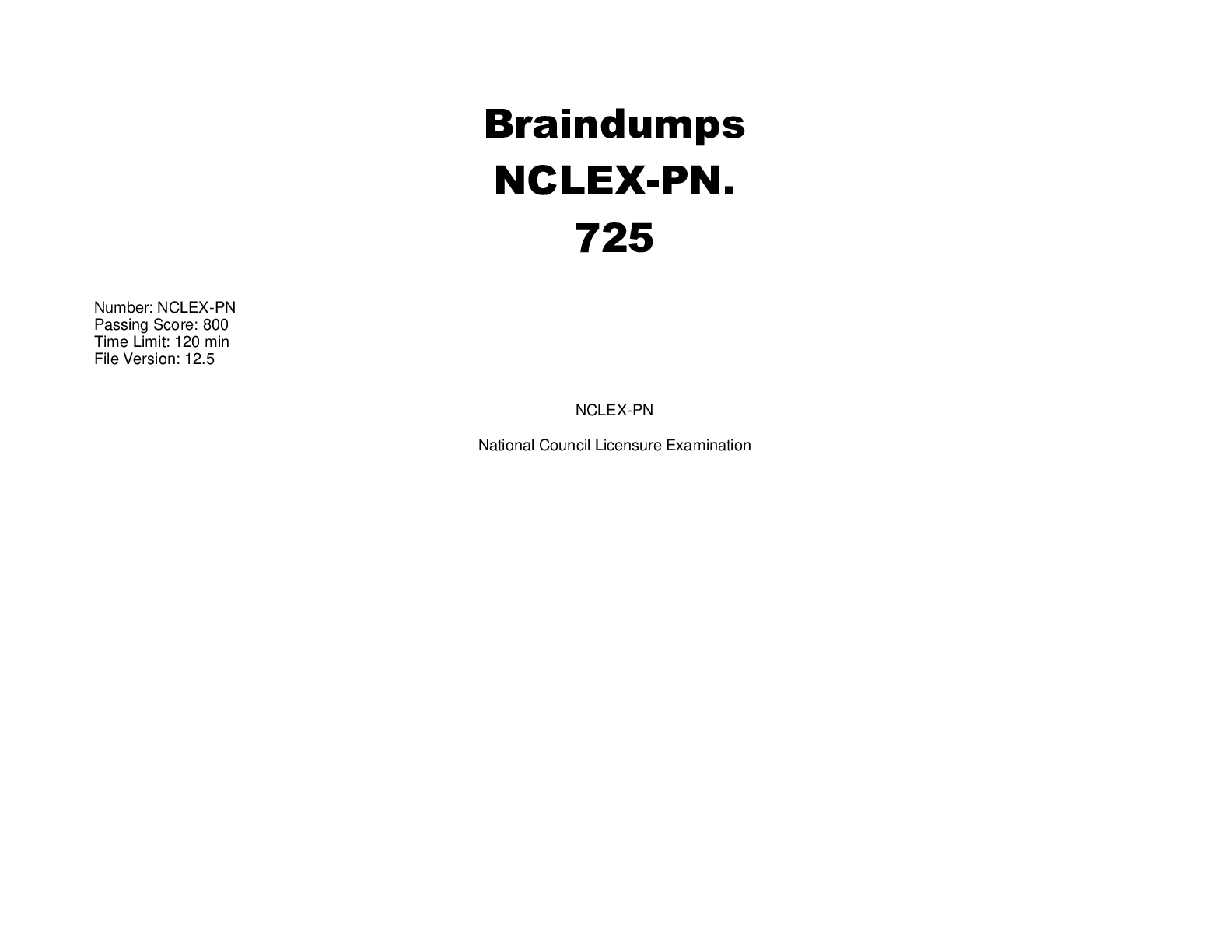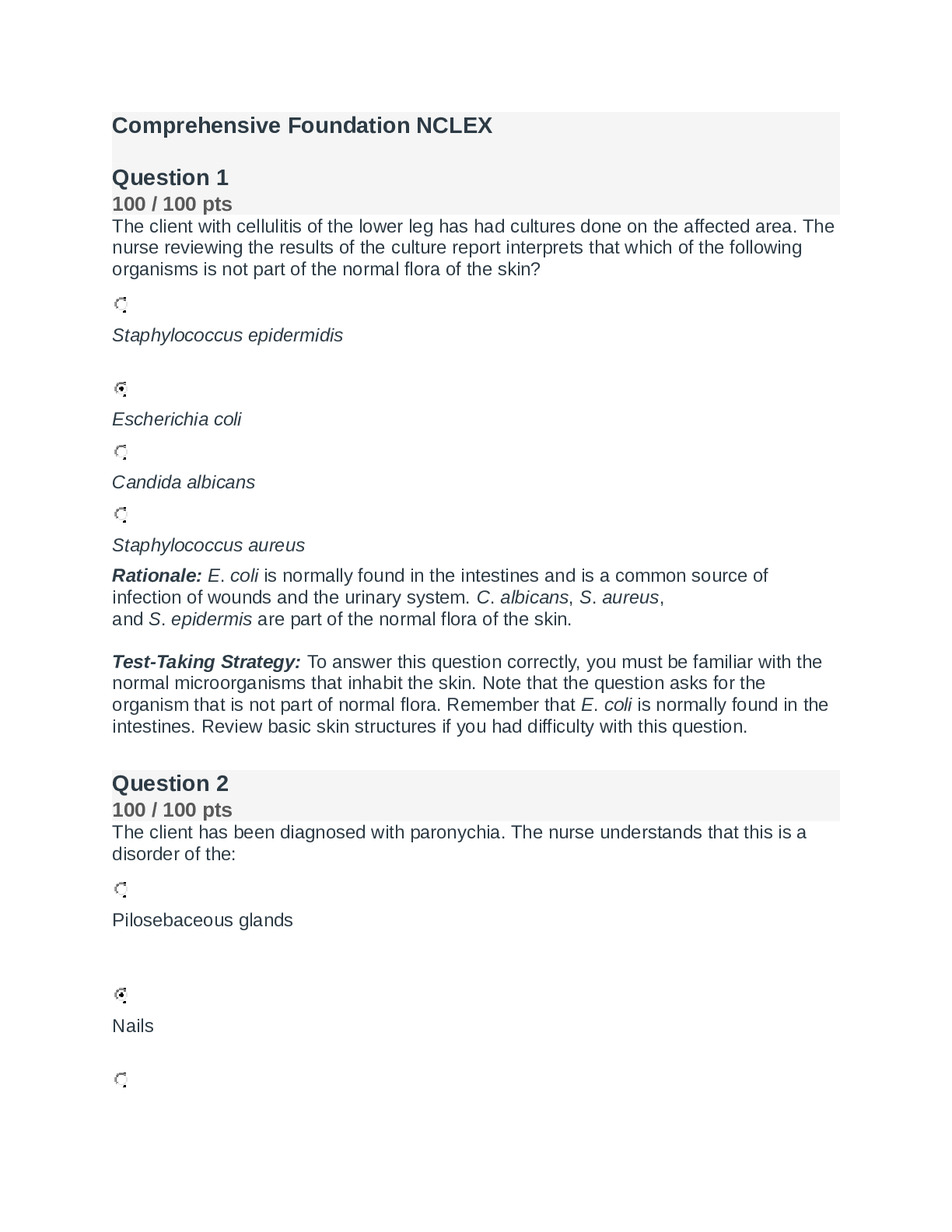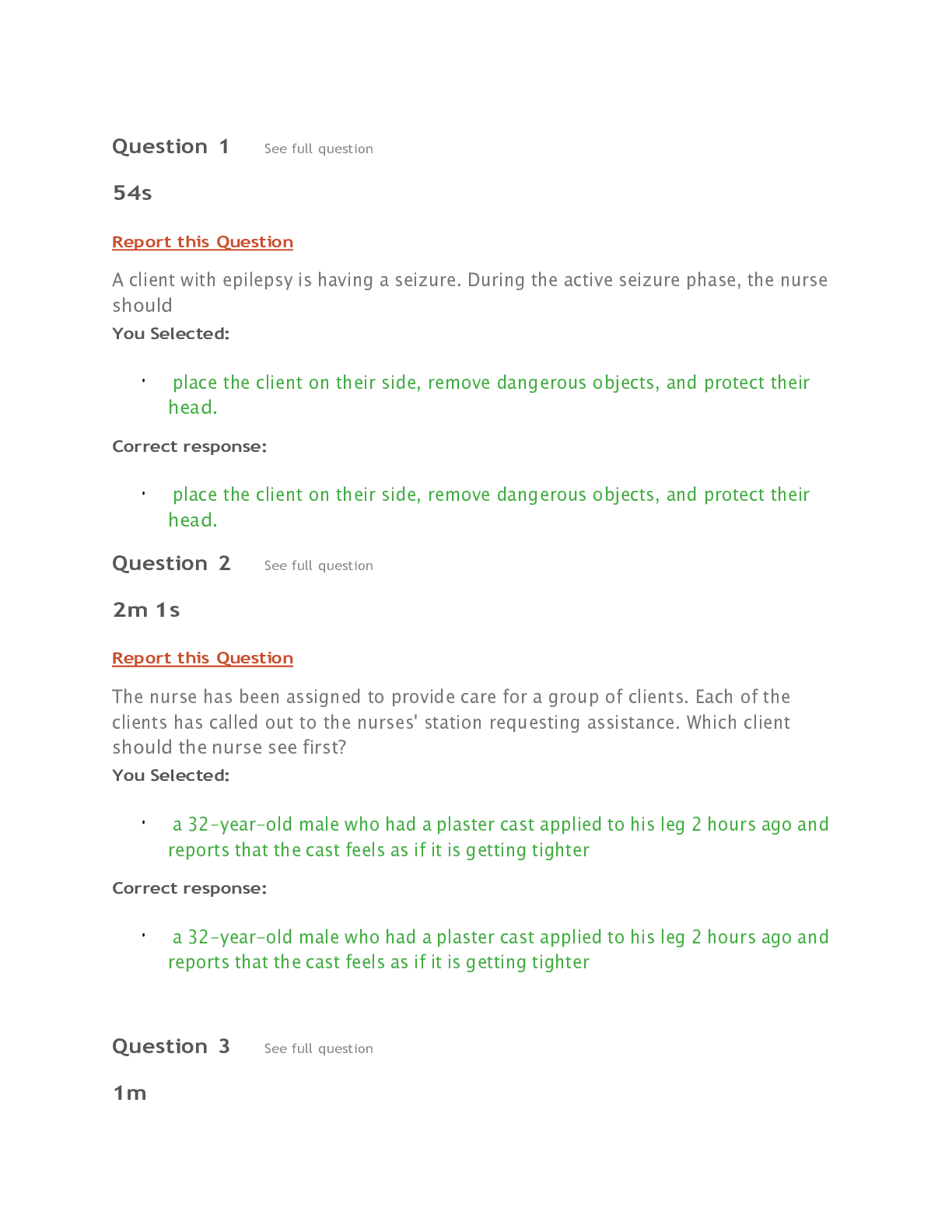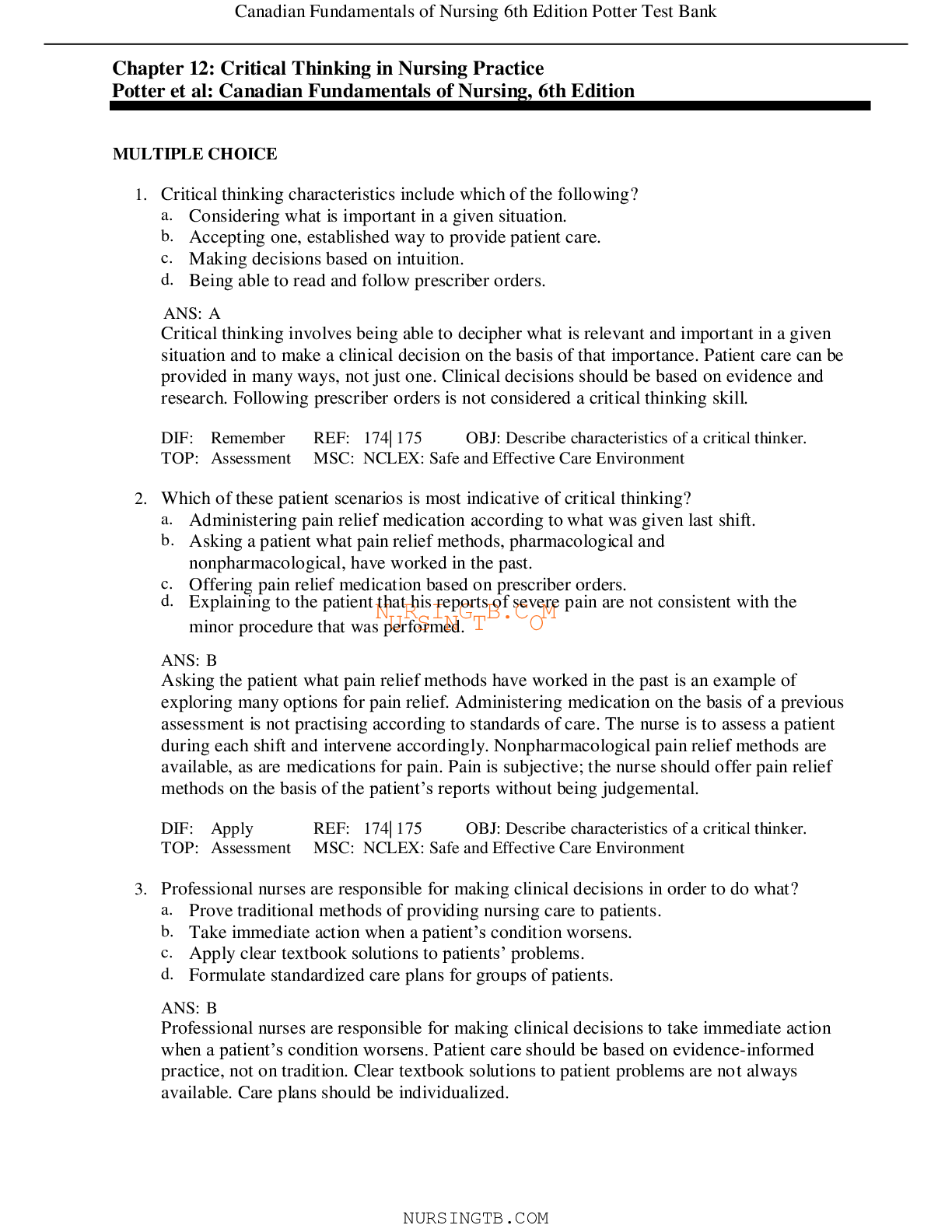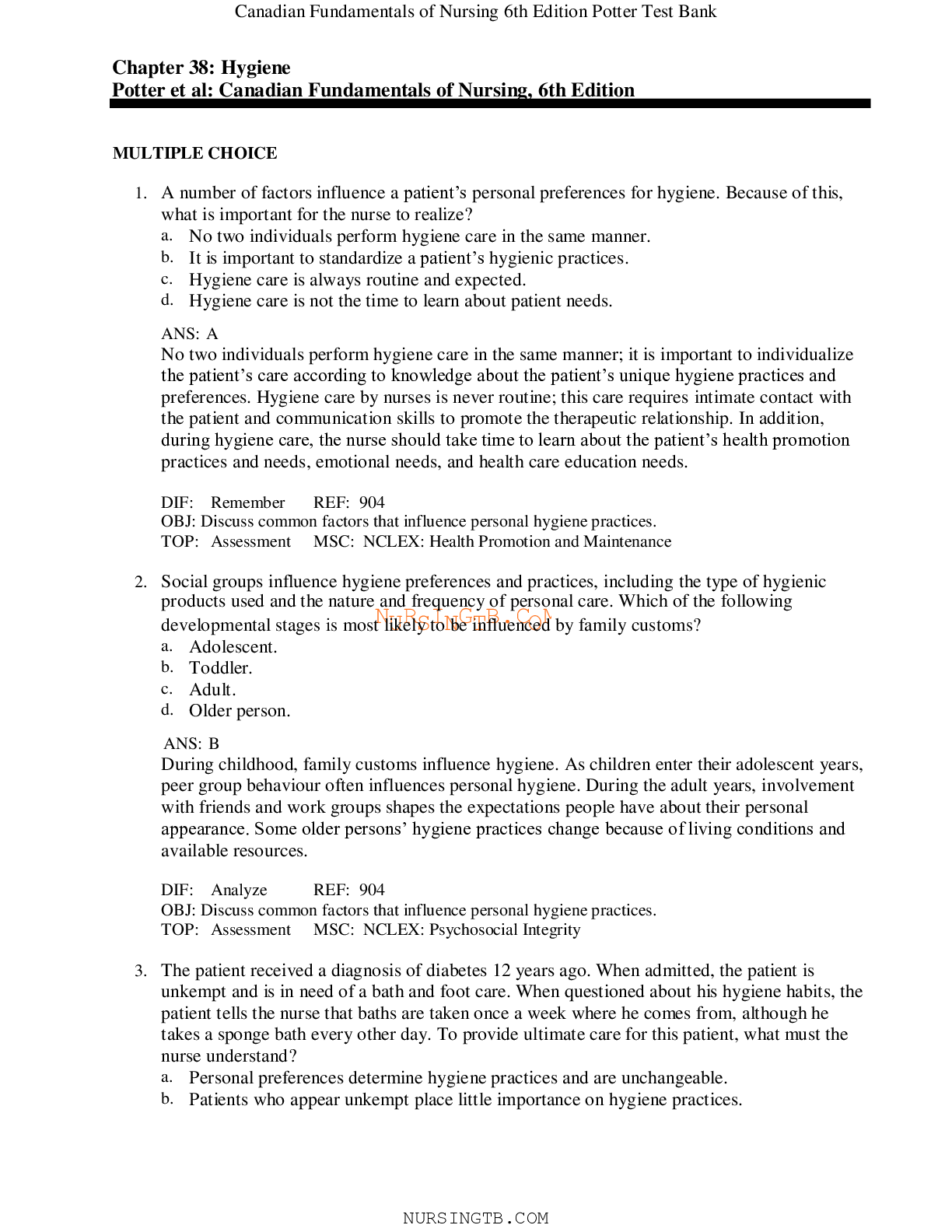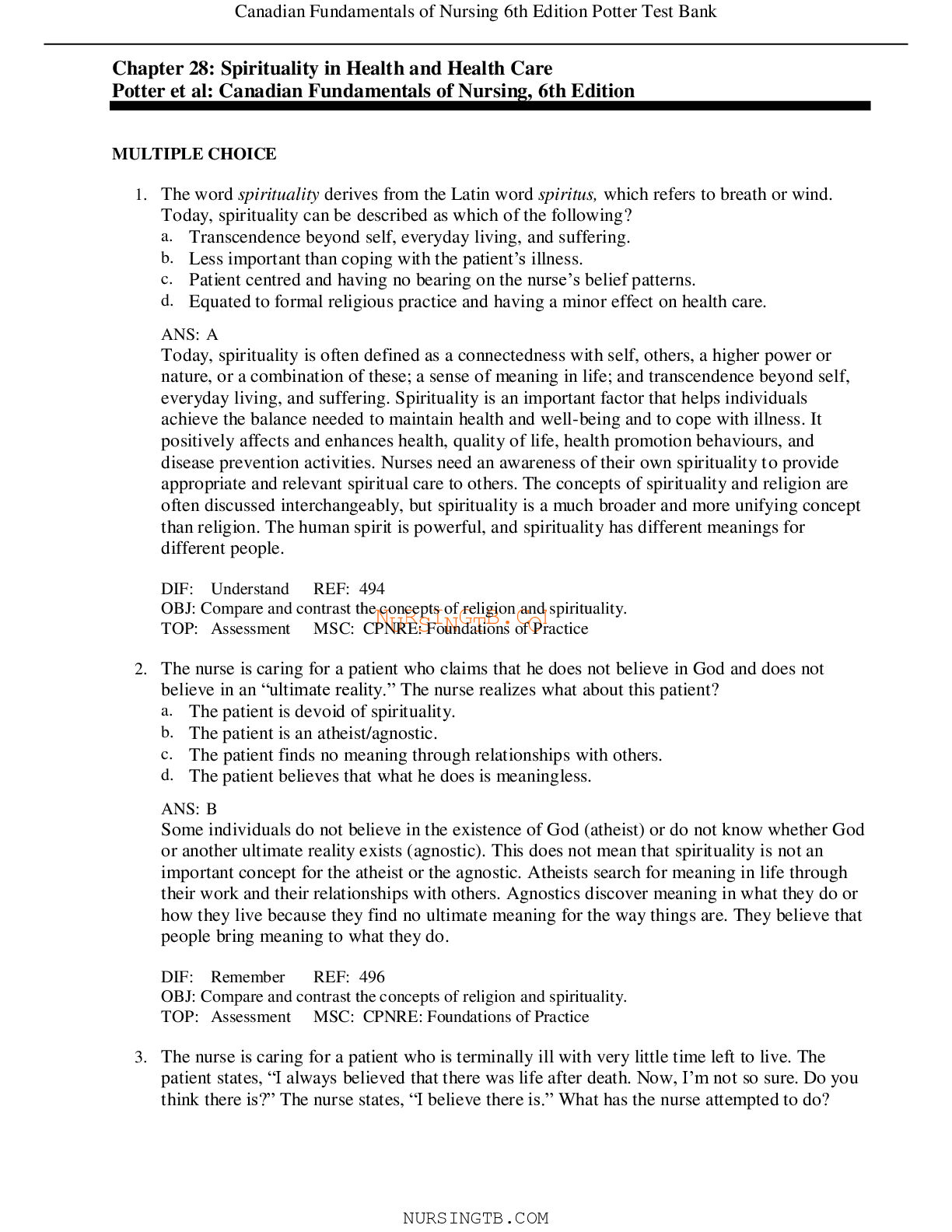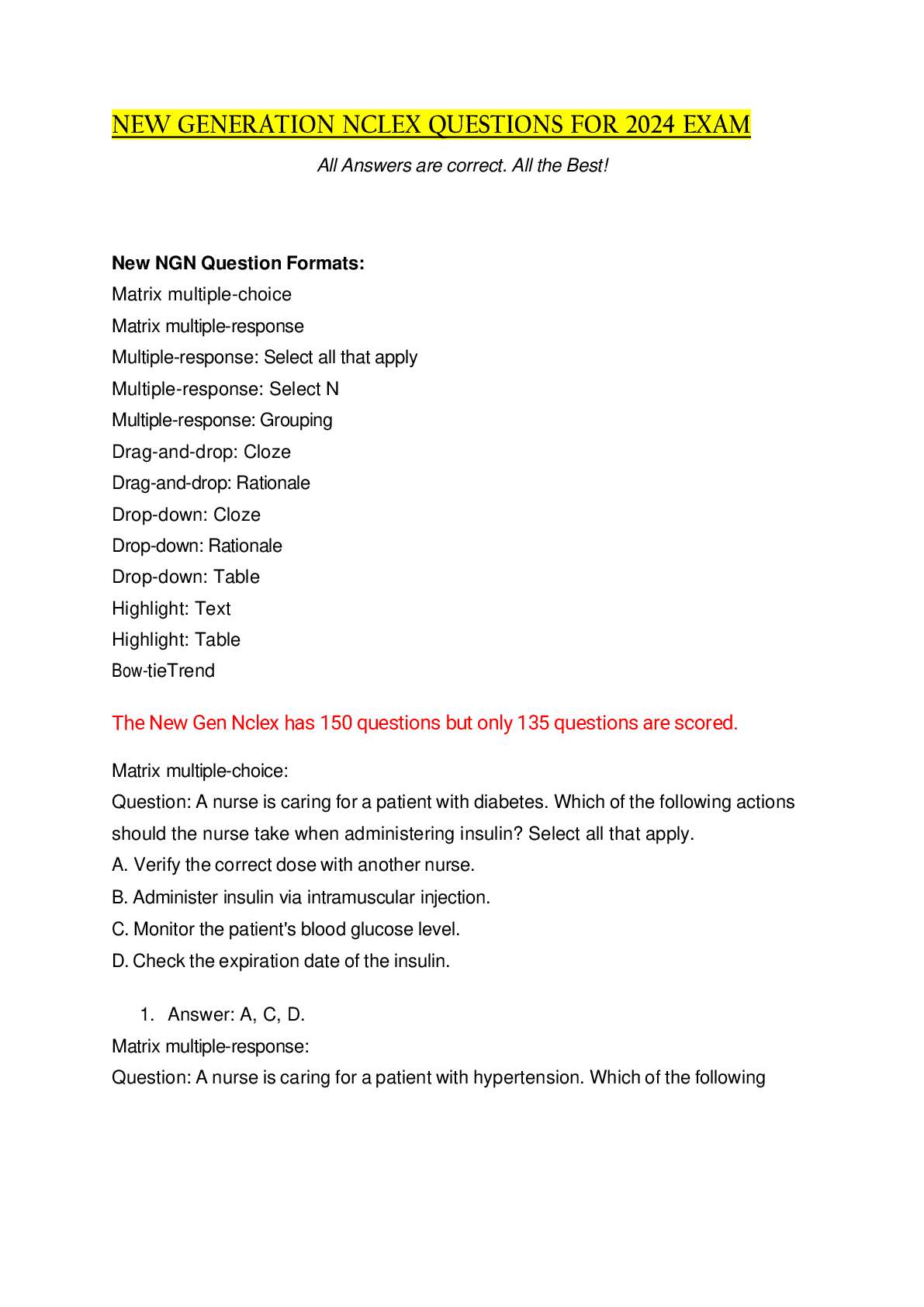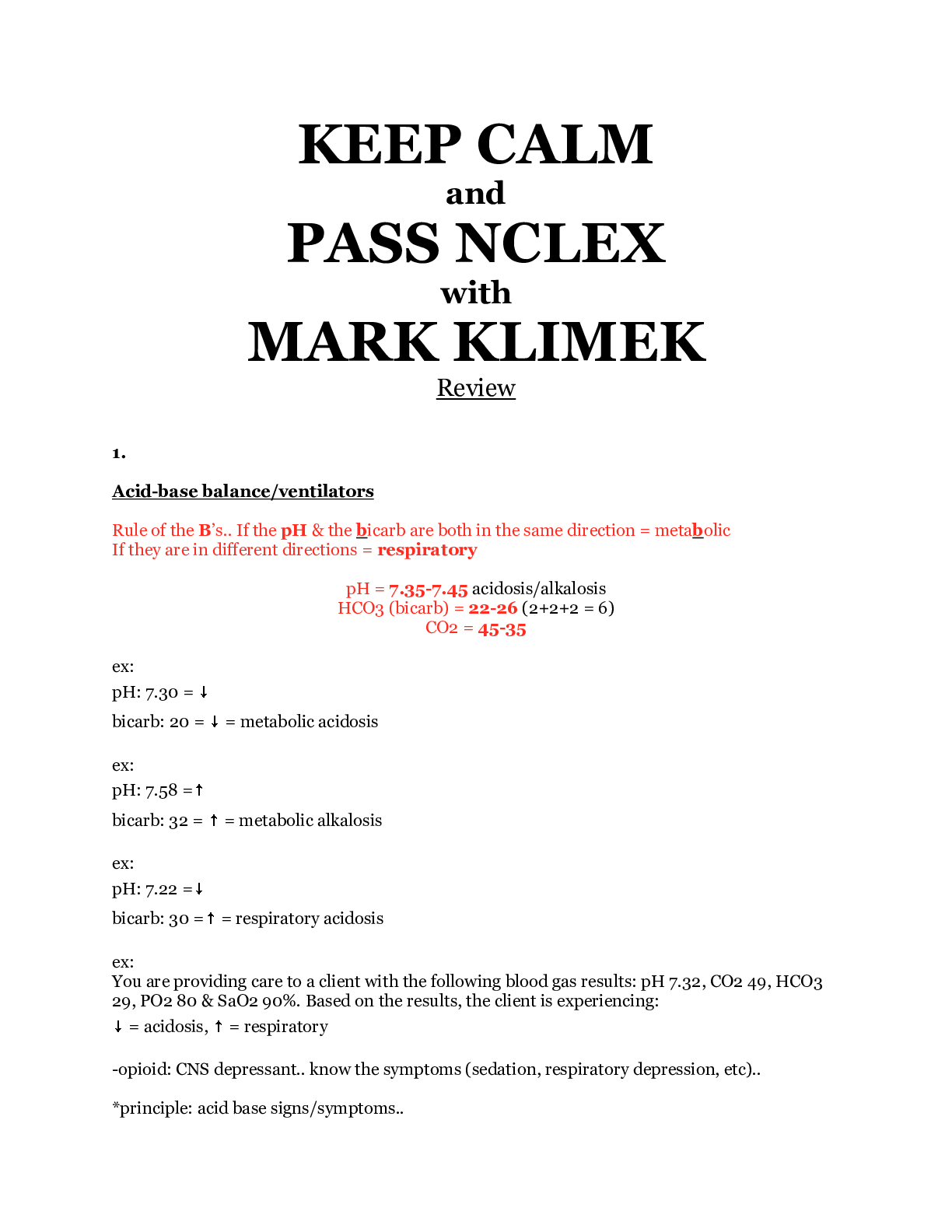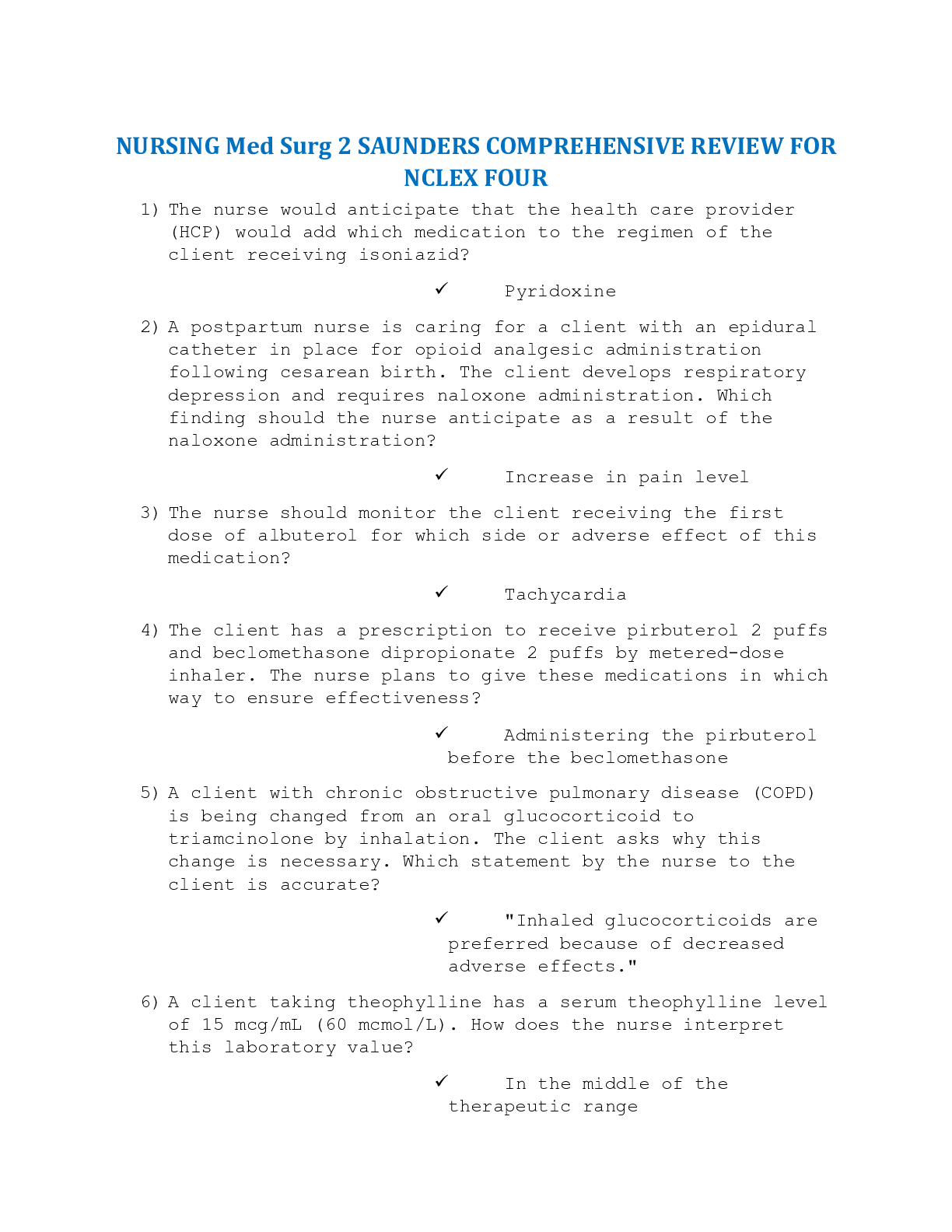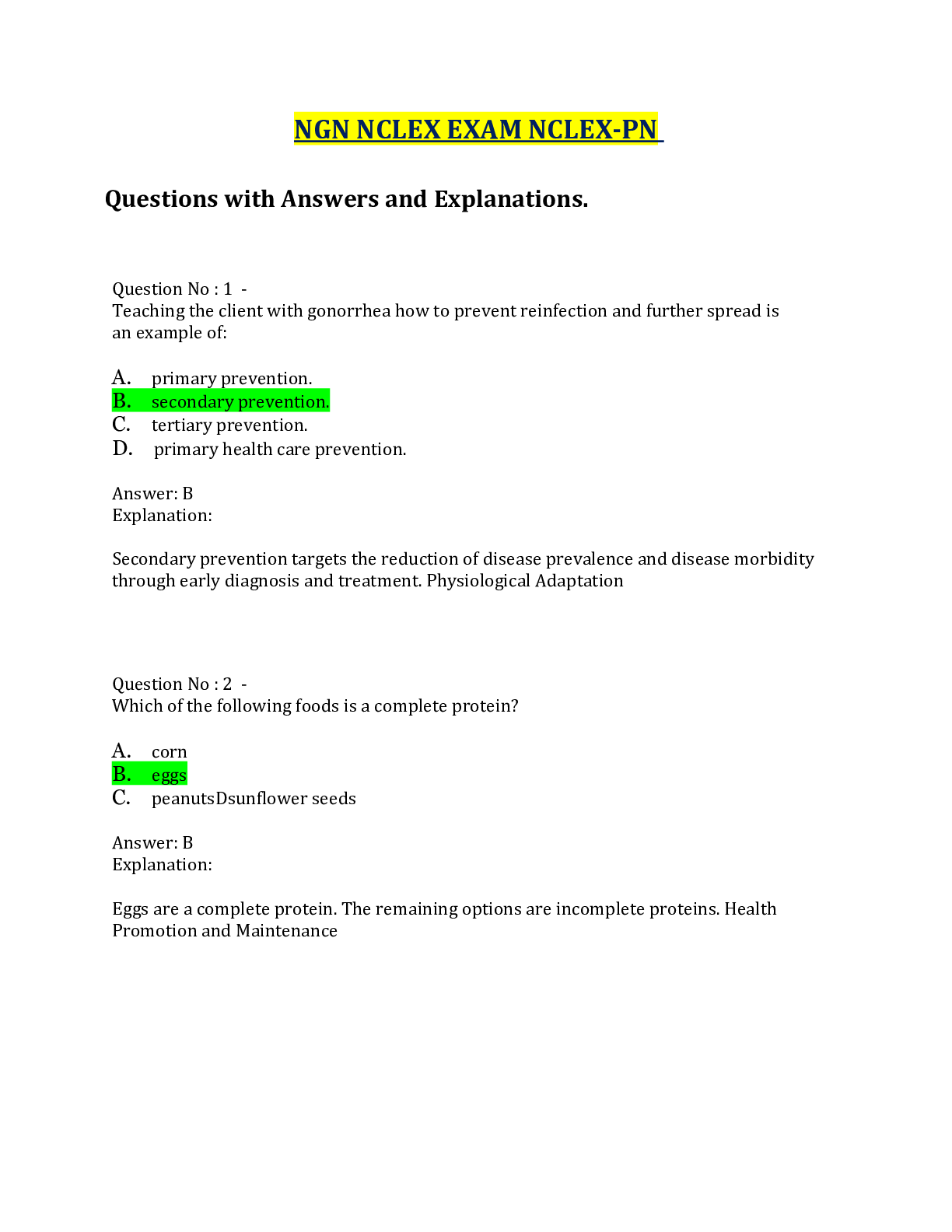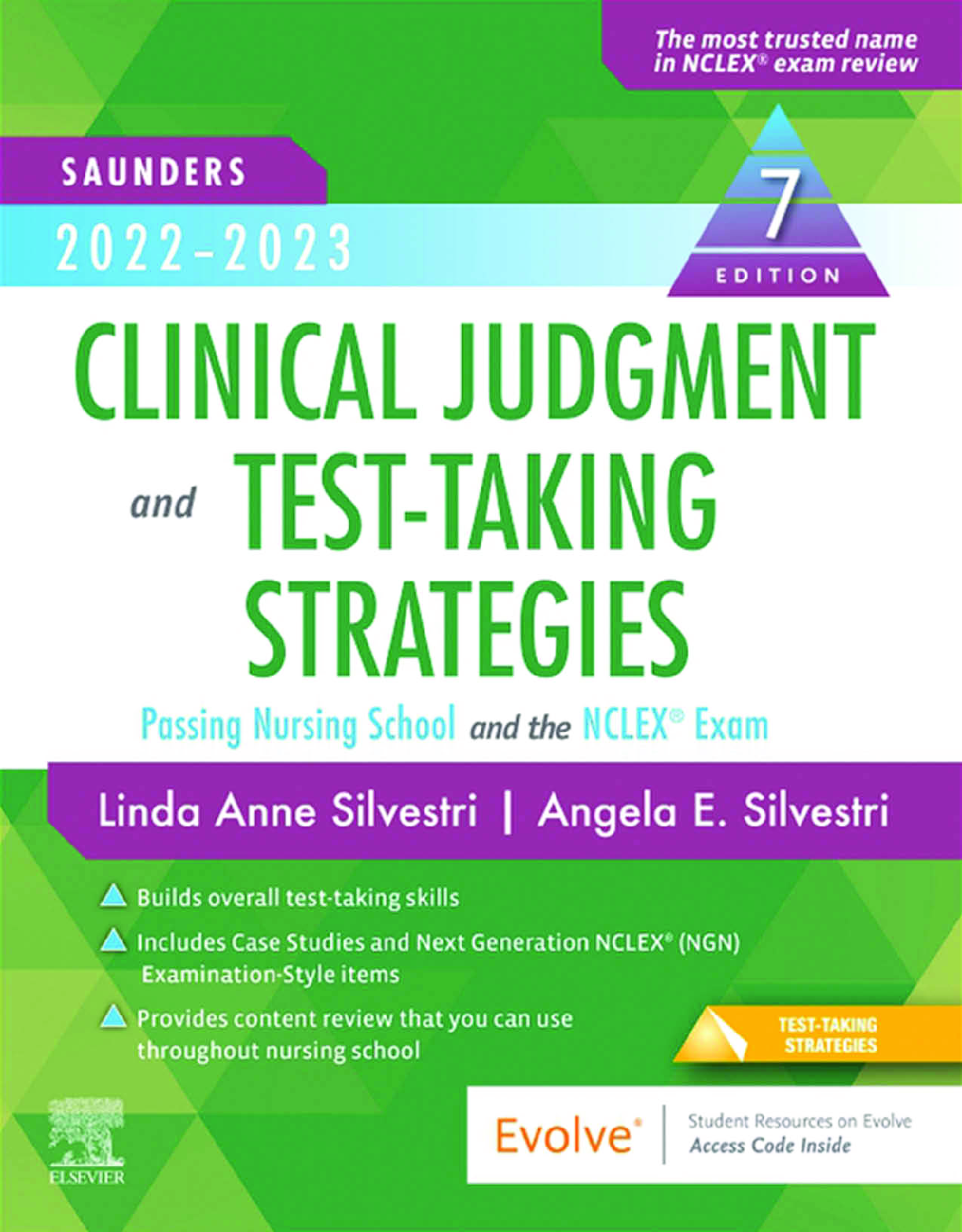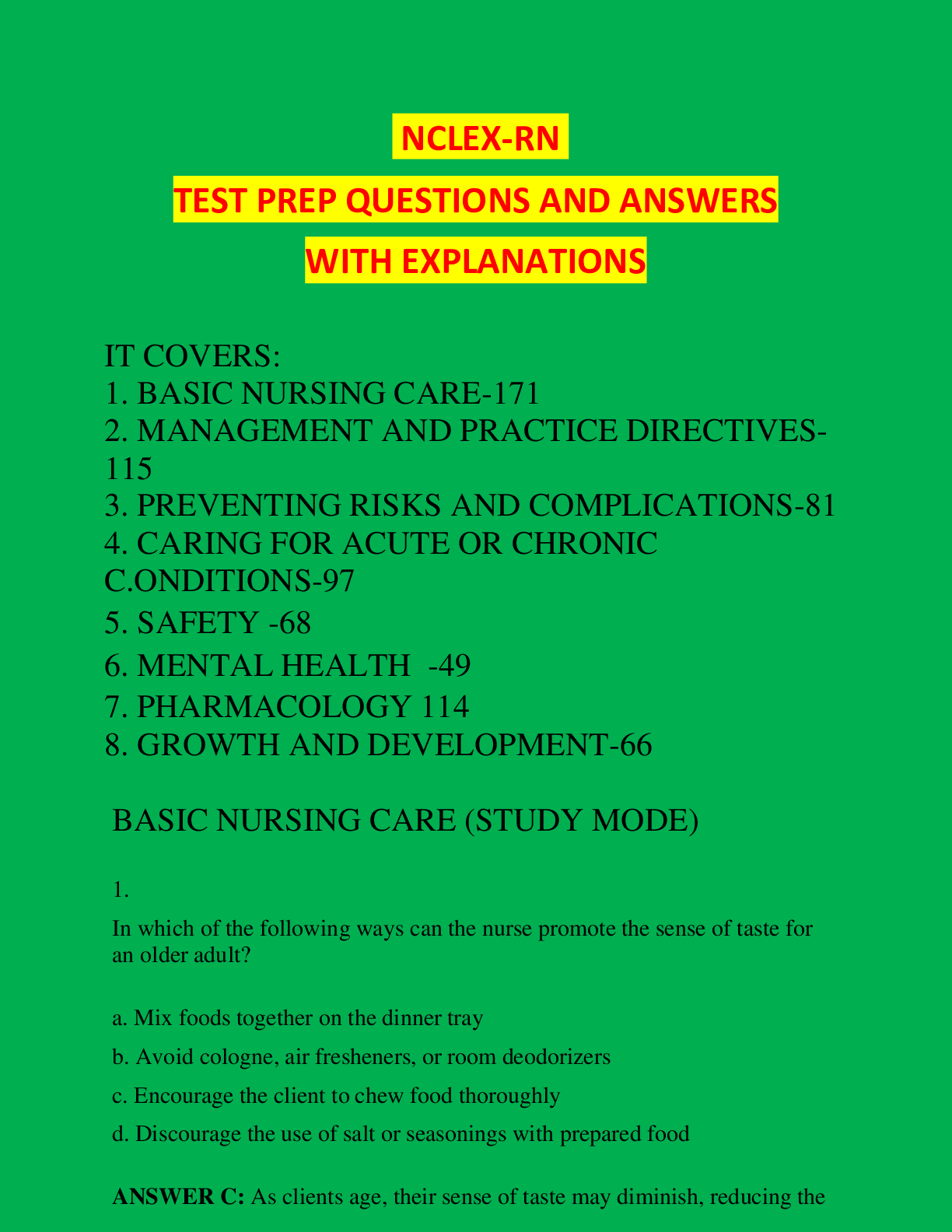*NURSING > NCLEX > Canadian Fundamentals of Nursing, 6th Edition Health and Wellness/QUESTIONS AND ANSWERS DEEPLY ELABO (All)
Canadian Fundamentals of Nursing, 6th Edition Health and Wellness/QUESTIONS AND ANSWERS DEEPLY ELABORATED
Document Content and Description Below
Chapter 01: Health and Wellness Potter et al: Canadian Fundamentals of Nursing, 6th Edition MULTIPLE CHOICE 1. The nurse is using the population health promotion model to develop actions for... improving health. After asking, “On what should we take action?”; “How should we take action?”; and “Why should we take action?” the nurse will ask which of the following questions? 2. The principle “Health promotion is multisectoral” means which of the following? 3. According to the World Health Organization, what is the best description of “health”? 4. What priority strategy for health promotion in Canada is optional but seen as important to incorporate in nursing education curricula? 5. Which of the following is a prerequisite for health, as identified by the Ottawa Charter for Health Promotion? 6. The determinant of health with the greatest effect on the health of Canadians is which of the following? 7. A paraplegic patient in the hospital for an electrolyte imbalance is receiving care at which prevention level? 8. The nurse incorporates levels of prevention on the basis of patient needs and the type of nursing care provided. Which of the following is an example of tertiary level preventive caregiving? Tertiary prevention is provided when a defect or disability is permanent and irreversible. At this level, the hospice nurse aims to help the patient and his or her family to achieve a high level of function, despite the limitations caused by the patient’s illness. Teaching a patient how to irrigate a new colostomy is an example of secondary prevention. If the colostomy is to be permanent, care may later move to the tertiary level of prevention. Providing a lesson on hygiene for an elementary school class and informing a patient about available immunizations are examples of primary prevention. DIF: Apply REF: 11 OBJ: Discuss the three levels of disease prevention. TOP: Implementation MSC: NCLEX: Health Promotion and Maintenance 9. The nurse is working on a committee to evaluate the need for increasing the levels of fluoride in the drinking water of the community. In doing so, the nurse is fostering which concept? a. Anticipatory prevention. b. Primary prevention. c. Secondary prevention. d. Tertiary prevention. ANS: B Fluoridation of municipal drinking water and fortification of homogenized milk with vitamin D are examples of primary prevention strategies. With active strategies of health promotion, individuals are motivated to adopt specific health programs such as weight reduction and smoking cessation programs. “Anticipatory prevention” is not a known concept. Secondary prevention promotes early detection of disease (e.g., screening). Tertiary prevention activities are initiated in the convalescence phase of disease. DIF: Apply REF: 11N R I GOBBJ:.DiC scMuss the three levels of disease prevention. TOP: Implementation U S N MTSC: NCOLEX: Health Promotion and Maintenance 10. The nurse is working in a clinic that is designed to provide health education and immunizations. As such, this clinic focuses on which type of prevention? a. Primary prevention. b. Secondary prevention. c. Tertiary prevention. d. Diagnosis and prompt intervention. ANS: A Primary prevention precedes disease or dysfunction and is applied to people considered physically and emotionally healthy. Health promotion includes health education programs, immunizations, and physical and nutritional fitness activities. Secondary prevention focuses on individuals who are experiencing health problems or illnesses and who are at risk for developing complications or worsening conditions; activities are directed at diagnosis and prompt intervention. Tertiary prevention is provided when a defect or disability is permanent and irreversible. It involves minimizing the effects of long-term disease or disability through interventions directed at preventing complications and deterioration. DIF: Understand REF: 11 OBJ: Discuss the three levels of disease prevention. TOP: Implementation MSC: NCLEX: Health Promotion and Maintenance 11. The patient is admitted to the emergency department of the local hospital from home with reports of chest discomfort and shortness of breath. She is administered oxygen and breathing treatments, laboratory tests and blood gas measurements are performed, and electrocardiography is conducted. What level of preventive care is this patient receiving? a. Primary prevention. b. Secondary prevention. c. Tertiary prevention. d. Health promotion. ANS: B Secondary prevention focuses on individuals who are experiencing health problems or illnesses and who are at risk for developing complications or worsening conditions. Activities are directed at diagnosis and prompt intervention. Primary prevention precedes disease or dysfunction and is applied to people considered physically and emotionally healthy. Health promotion includes health education programs, immunizations, and physical and nutritional fitness activities. Tertiary prevention is provided when a defect or disability is permanent and irreversible. It involves minimizing the effects of long-term disease or disability through interventions directed at preventing complications and deterioration. DIF: Apply REF: 11 OBJ: Discuss the three levels of disease prevention. TOP: Implementation MSC: NCLEX: Health Promotion and Maintenance 12. A patient is admitted to a rehabilitation facility after a stroke. The patient has right-sided paralysis and is unable to speak. The patient will be receiving physiotherapy and speech therapy. What are these examples of? a. Primary prevention. b. Secondary prevention. c. Tertiary prevention. d. Health promotion. ANS: C NURSINGTB.COM Tertiary prevention is provided when a defect or disability is permanent and irreversible. It involves minimizing the effects of long-term disease or disability through interventions directed at preventing complications and deterioration. Secondary prevention focuses on individuals who are experiencing health problems or illnesses, and who are at risk for developing complications or worsening conditions. Activities are directed at diagnosis and prompt intervention. Primary prevention precedes disease or dysfunction and is applied to people considered physically and emotionally healthy. Health promotion includes health education programs, immunizations, and physical and nutritional fitness activities. DIF: Apply REF: 11 OBJ: Discuss the three levels of disease prevention. TOP: Implementation MSC: NCLEX: Health Promotion and Maintenance 13. Risk factors can be placed in the following interrelated categories: genetic and physiological factors, age, physical environment, and lifestyle. The presence of any of these risk factors means which of the following? a. A person with the risk factor will get the disease. b. The chances of getting the disease are increased. c. The disease is guaranteed not to develop if the risk factor is controlled. d. Risk modification will have no effect on disease prevention. ANS: B The presence of risk factors does not mean that a disease will develop, but risk factors increase the chances that the individual will experience a particular disease or dysfunction. Control of risk factors does not guarantee that a disease will not develop. However, risk factor identification assists patients in visualizing those areas in life that can be modified or even eliminated to promote wellness and prevent illness. DIF: Knowledge REF: 3 OBJ: Identify factors that have led to each approach to health. TOP: Assessment MSC: NCLEX: Health Promotion and Maintenance 14. Since the early 1990s, which group has had the highest amount of absenteeism of all workers in Canada? a. “White collar sector” workers. b. Nurses. c. Workers in the trades. d. Transport and equipment operators. ANS: B There is considerable concern regarding negative workplace conditions in the health care sector. Nurses have had the highest or second-highest rate of absenteeism of all workers in Canada since the early 1990s. Rates of absenteeism for the “white collar sector,” for workers in the trades, and for transport and equipment operators are not available. DIF: Analyze REF: 7 OBJ: Analyze how the nature and scope of nursing practice are influenced by different conceptualizations of health and health determinants. TOP: Planning MSC: NCLEX: Health PromotNioUn aRnSd IMNaiGnteTnBan.ceCOM 15. Which of the following is a true statement about nutrition in Canada, according to the research? a. Canadians have increased their total fat and salt consumption. b. Canadians report that their children eat the recommended daily number of fruits and vegetables. c. Fifty percent of children aged 2 to 17 years are overweight or obese. d. The 2004 Canadian Community Health Survey (CCHS) revealed that 40% of adult Canadians were obese (body mass index of 30 or more) and 50% were overweight. ANS: A One quarter of Canadians overall, and one third of teenagers aged 14 to 18 years, reported eating at a fast-food outlet the previous day; such foods are high in fats and salts. Seventy percent of children aged 4 to 8 ate fewer than the minimum servings of fruits and vegetables daily. Of children aged 2 to 17 years, 26% were overweight or obese, not 50%. The 2004 Canadian Community Health Survey (CCHS) revealed that 23% of adult Canadians were obese (body mass index of 30 or more), not 40%, and 36% were overweight, not 50%. DIF: Apply REF: 8| 9 OBJ: Discuss key health determinants and their interrelationships and how they influence health. TOP: Planning MSC: NCLEX: Health Promotion and Maintenance 16. One of the five health promotion strategies, as identified by the Ottawa Charter for Health Promotion, is which of the following? a. Creating supportive environments. b. Strengthening educational opportunities. c. Developing a medical approach. d. Minimizing stressful situations. ANS: A “Creating supportive environments” is one of the five broad health promotion strategies identified by the Ottawa Charter for Health Promotion. The other strategies are building healthy public policy, strengthening community action, developing personal skills, and reorienting health services. “Strengthening educational opportunities,” “Developing a medical approach,” and “Minimizing stressful situations” are not among the five strategies. DIF: Apply REF: 11| 12 OBJ: Discuss contributions of the following Canadian publications to conceptualizations of health and health determinants: Lalonde Report, Ottawa Charter, Epp Report, Strategies for Population Health, Jakarta Declaration, Bangkok Charter, Toronto Charter. TOP: Planning MSC: NCLEX: Health Promotion and Maintenance 17. Which of the following is an example of tertiary prevention? a. Reduction of risk factors, such as smoking. b. Breast self-examination and testicular self-examination. c. Cardiac rehabilitation programs. d. Blood pressure screening to detect hypertension. ANS: C Tertiary prevention activitiesNoccRur iIn thGe coBn.vaClescMence stage of disease and are directed toward minimizing residual disability and helping people to live productively with limitations. An example is a cardiac rehabilitation program after a myocardial infarction. Breast self-examination and testicular self-examination are examples of secondary prevention, as is blood pressure screening to detect hypertension. Reducing risk factors, such as smoking, is an example of primary prevention. DIF: Understand REF: 11 OBJ: Describe the three levels of disease prevention. TOP: Implementation MSC: NCLEX: Health Promotion and Maintenance 18. When the nurse is educating an adult patient about health promotion activities, which of the following is the most important internal patient factor for the nurse to consider? a. Emotional wellness. b. Developmental stage. c. Professed spirituality. d. Levels of education and literacy. ANS: D Levels of education and literacy are important influences to consider when the nurse is educating an adult patient about health promotion activities. Literacy can influence health both directly (e.g., with regard to medication use, safety practices) as well as indirectly (through use of services, lifestyles, income, work environments, and stress levels). Spirituality is reflected in a person’s values and beliefs, the relationships established with family and friends, and the ability to find hope and meaning in life; however, these can change throughout life; however, it is not the most important factor to consider. The nurse must consider the patient’s level of growth and development when using the patient’s health beliefs and practices as a basis for planning care, but this is not the most important patient factor to consider. In this case, the patient is at the adult developmental stage. The patient’s emotional wellness—degree of stress, depression, or fear, for example—can influence health beliefs and practices. The manner in which a person handles stress throughout each phase of life will influence the way he or she reacts to illness. However, this is not the best available option. DIF: Analyze REF: 7 OBJ: Discuss key health determinants and their interrelationships and how they influence health. TOP: Implementation MSC: NCLEX: Health Promotion and Maintenance 19. When discussing the effect of a known risk factor on a patient’s health, what would the nurse would say? a. “It doesn’t mean that you’ll get the disease, just that the odds are greater for you.” b. “Now that you know the possibility is there, you can take steps to prevent it.” c. “This risk factor can be managed by making a change to your lifestyle.” d. “You’re lucky because you have the benefit of being able to do something about it.” ANS: A NURSINGTB.COM The presence of risk factors does not mean that a disease will develop, but risk factors increase the chances that the individual will experience a particular disease or dysfunction. Although the statement “Now that you know the possibility is there, you can take steps to prevent it” is not incorrect, it does not address the effect of the risk factor on the patient’s health. It is not always true that a risk factor can be managed by making lifestyle changes. The strategy of telling the patient that he or she is lucky and has the benefit of being able to do something about a risk factor minimizes the patient’s concern, and does not address the effect of the risk factor on the patient’s health. DIF: Apply REF: 3 OBJ: Describe key characteristics of medical, behavioural, and socioenvironmental approaches to health. TOP: Implementation MSC: NCLEX: Health Promotion and Maintenance MULTIPLE RESPONSE 1. Classifications of health conceptualizations occur in which ways? (Select all that apply.) a. Health as stability. b. Health as free from illness. c. Health as universal. d. Health as actualization. e. Health as individual. ANS: A, D Health can be conceptualized (Pender, 2006) in three ways: health as stability, health as actualization, and health as both of these together. DIF: Understand REF: 2 OBJ: Discuss ways that definitions of health have been conceptualized. TOP: Assessment MSC: NCLEX: Health Promotion and Maintenance 2. Health challenges, as identified by Achieving Health for All: A Framework for Health Promotion (Epp, 1986), include which of the following? (Select all that apply.) a. Mutual aid b. Reducing inequities c. Increasing prevention d. Enhancing coping ANS: B, C, D Health challenges, as identified by Epp (1986), include reducing inequities, increasing prevention, and enhancing coping. Mutual aid is a health promotion mechanism in the framework; it does not refer to a health challenge. DIF: Understand REF: 4 OBJ: Discuss contributions of the following Canadian publications to conceptualizations of health and health determinants: Lalonde Report, Ottawa Charter, Epp Report, Strategies for Population Health, Jakarta Declaration, Bangkok Charter, Toronto Charter. TOP: Assessment MSC: NCLEX: Health Promotion and Maintenance NURSINGTB.COM [Show More]
Last updated: 1 year ago
Preview 1 out of 9 pages
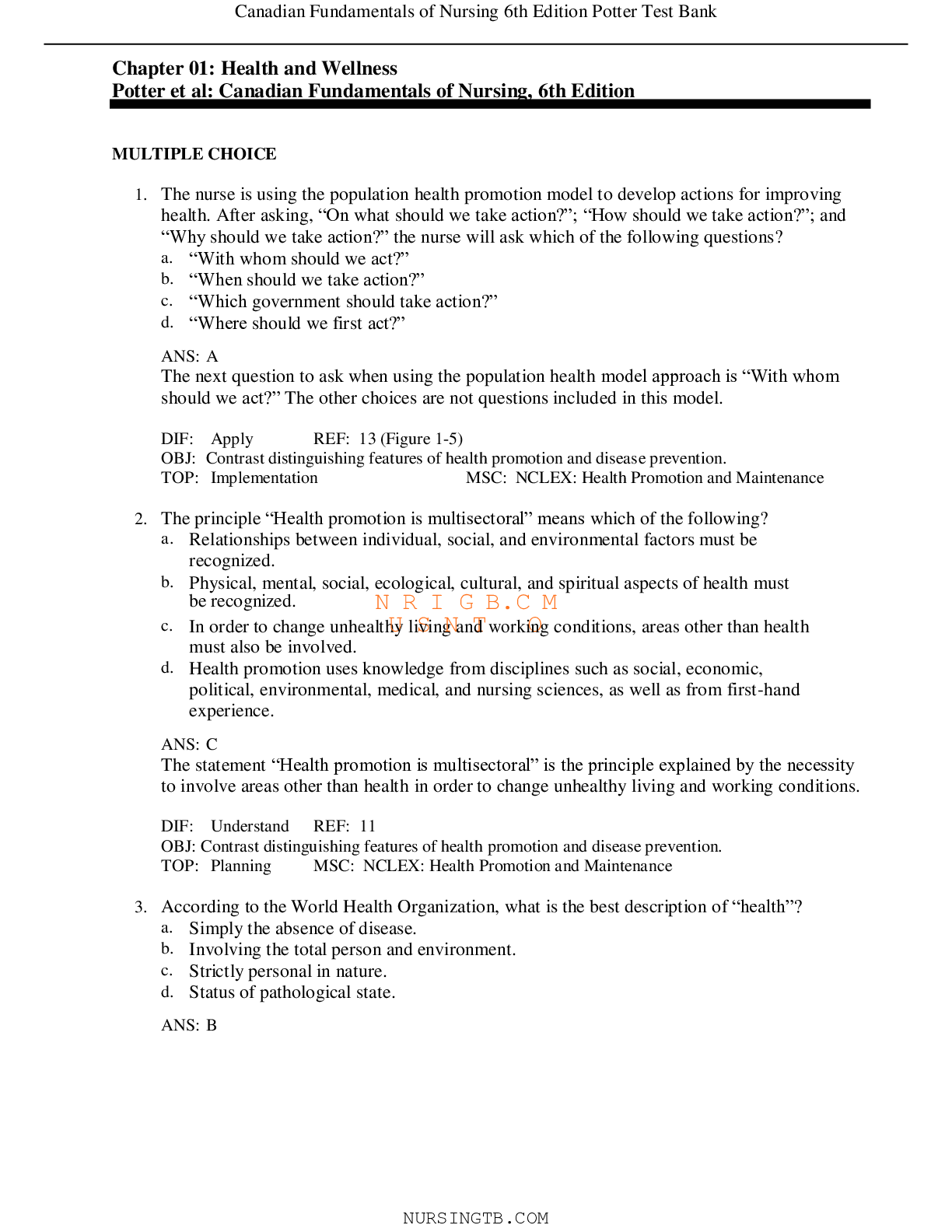
Reviews( 0 )
Document information
Connected school, study & course
About the document
Uploaded On
Aug 07, 2021
Number of pages
9
Written in
Additional information
This document has been written for:
Uploaded
Aug 07, 2021
Downloads
0
Views
70


